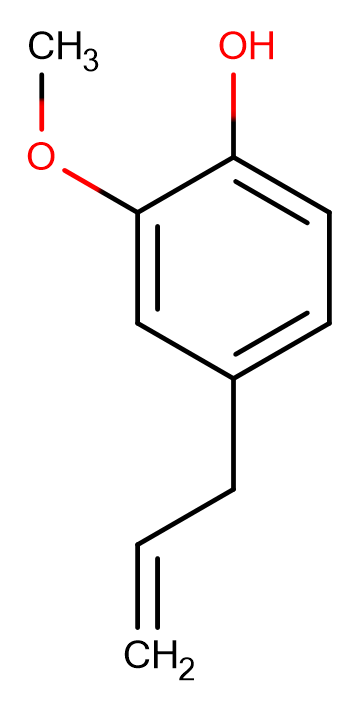
Eugenol
CAS No. 97-53-0
Eugenol( Eugenol | NSC 209525 | NSC-209525 | NSC209525 )
Catalog No. M16881 CAS No. 97-53-0
Eugenol is a Standardized Chemical Allergen. The physiologic effect of eugenol is by means of Increased Histamine Release and Cell-mediated Immunity.
Purity : >98% (HPLC)
 COA
COA
 Datasheet
Datasheet
 HNMR
HNMR
 HPLC
HPLC
 MSDS
MSDS
 Handing Instructions
Handing Instructions
| Size | Price / USD | Stock | Quantity |
| 100MG | 49 | In Stock |


|
| 200MG | 87 | In Stock |


|
| 500MG | Get Quote | In Stock |


|
| 1G | Get Quote | In Stock |


|
Biological Information
-
Product NameEugenol
-
NoteResearch use only, not for human use.
-
Brief DescriptionEugenol is a Standardized Chemical Allergen. The physiologic effect of eugenol is by means of Increased Histamine Release and Cell-mediated Immunity.
-
DescriptionEugenol is a Standardized Chemical Allergen. The physiologic effect of eugenol is by means of Increased Histamine Release and Cell-mediated Immunity. The chemical classification of eugenol is Allergens. (In Vitro):The essential oil of O. gratissimum, as well as eugenol, are efficient in inhibiting eclodibility of H. contortus eggs, showing possible utilizations in the treatment of gastrointestinal helmintosis of small ruminants. At 0.50% concentration, the essential oil and eugenol show a maximum eclodibility inhibition. Eugenol inhibits superoxide anion generation in xanthine-xanthine oxidase system to an extent of 50% at concentrations of 250 μM. Eugenol also inhibits the generation of hydroxyl radicals to an extent of 70%. The OH-radical formation measured by the hydroxylation of salicylate to 2, 3-dihydroxy benzoate is inhibited to an extent of 46% by eugenol at 250 μM. Eugenol protects against RS-induced development of IBS-like gastrointestinal dysfunction through modulation of HPA-axis and brain monoaminergic pathways apart from its antioxidant effect. Eugenol (50?mg/kg) reduces 80% of RS-induced increase in fecal pellets similar to that of ondansetron. Eugenol attenuates 80% of stress-induced increase in plasma corticosterone and modulates the serotonergic system in the PFC and amygdala. Eugenol attenuates stress-induced changes in norepinephrine and potentiates the antioxidant defense system in all brain regions.(In Vivo):Eugenol (33 mg/kg) administered orally for 2 days causes significant suppression of knee joint edema, which continues to be significantly reduced at the end of the treatment. After 2 days, eugenol-treated mycobacterial arthritic rats show a marked reduction in paw swelling.
-
In VitroThe essential oil of O. gratissimum, as well as eugenol, are efficient in inhibiting eclodibility of H. contortus eggs, showing possible utilizations in the treatment of gastrointestinal helmintosis of small ruminants. At 0.50% concentration, the essential oil and eugenol show a maximum eclodibility inhibition. Eugenol inhibits superoxide anion generation in xanthine-xanthine oxidase system to an extent of 50% at concentrations of 250 μM. Eugenol also inhibits the generation of hydroxyl radicals to an extent of 70%. The OH-radical formation measured by the hydroxylation of salicylate to 2, 3-dihydroxy benzoate is inhibited to an extent of 46% by eugenol at 250 μM. Eugenol protects against RS-induced development of IBS-like gastrointestinal dysfunction through modulation of HPA-axis and brain monoaminergic pathways apart from its antioxidant effect. Eugenol (50?mg/kg) reduces 80% of RS-induced increase in fecal pellets similar to that of ondansetron. Eugenol attenuates 80% of stress-induced increase in plasma corticosterone and modulates the serotonergic system in the PFC and amygdala. Eugenol attenuates stress-induced changes in norepinephrine and potentiates the antioxidant defense system in all brain regions.
-
In VivoEugenol (33 mg/kg) administered orally for 2 days causes significant suppression of knee joint edema, which continues to be significantly reduced at the end of the treatment. After 2 days, eugenol-treated mycobacterial arthritic rats show a marked reduction in paw swelling.
-
SynonymsEugenol | NSC 209525 | NSC-209525 | NSC209525
-
PathwayOthers
-
TargetOther Targets
-
RecptorOthers
-
Research AreaOther Indications
-
Indication——
Chemical Information
-
CAS Number97-53-0
-
Formula Weight164.2
-
Molecular FormulaC10H12O2
-
Purity>98% (HPLC)
-
SolubilityDMSO: 10 mM
-
SMILESOC1=CC=C(CC=C)C=C1OC
-
Chemical NamePhenol, 2-methoxy-4-(2-propen-1-yl)-
Shipping & Storage Information
-
Storage(-20℃)
-
ShippingWith Ice Pack
-
Stability≥ 2 years
Reference
1. Jadhav BK, et al. Drug Dev Ind Pharm. 2004 Feb;30(2):195-203.
molnova catalog



related products
-
G3-C12 TFA (848301-9...
G3-C12 TFA Salt is a specific galectin-3 binding peptide with Ksubdsub of 88 nM and shows anticancer activity.
-
Bruceantin
Bruceantin is a natural product isolated from Brucea antidysenterica. Bruceantin has antitumor activity against B16 melanoma, colon 38, and L1210 and P388 leukemia in mice.
-
Droprenilamine
Droprenilamine (Valcor) is an alicyclic derivative of pentenylamine with antianginal properties.



 Cart
Cart
 sales@molnova.com
sales@molnova.com


